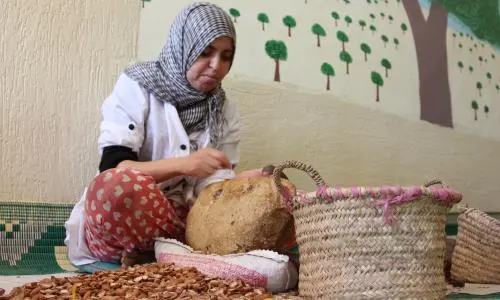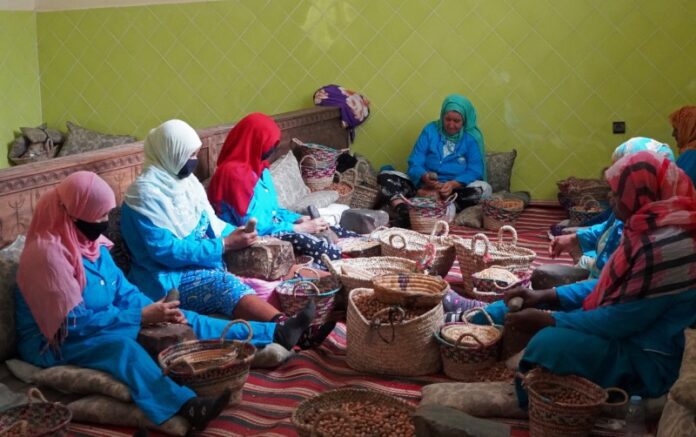Introduction
Argan oil cooperative farming is an important part of the culture and economy in southern Morocco. However, members of these cooperatives often face difficulties both in production and marketing of their argan oil. In this article, I will discuss some of the key challenges cooperative members deal with on a regular basis and explore possible opportunities to overcome these challenges. My goal is to have an insightful yet sensitive discussion that highlights both the difficulties as well as hope for a brighter future.
Processing and Production Challenges
One of the major challenges for argan oil cooperative members is the labor intensive nature of oil production from argan nuts. The entire process from collecting the nuts from trees, cracking them open, breaking the shells to extract the kernels, and grinding the kernels to extract the argan oil is very time consuming and physically demanding work. Typically this work is done manually using basic tools like scissors, knives, grindstones etc. This manual production process results in low yields of oil and impacts the incomes of cooperative members.
To address this challenge, some cooperatives have started experimenting with mechanical devices to assist with certain production steps. For example, some cooperatives have tried using manually operated machines for cracking open argan nuts and breaking the shells. While these machines have increased production efficiency to some extent, they are still not very effective and often break down easily due to low quality construction materials and lack of regular maintenance in remote villages. Most cooperative members cannot afford to purchase higher quality electric powered machines due to financial constraints.
Another challenge related to production is the variable quality and inconsistent composition of argan oil extracted manually. Factors like inadequate drying of kernels prior to pressing, insufficient grinding of kernels, improper filtration techniques etc can affect the clarity, color and nutrient content of the final oil. This makes it difficult for cooperatives to market their oil as a premium product. Some quality control and training on improved production methods could help resolve this issue.
Storage and Packaging Issues
With manually extracted oil in large quantities, proper storage becomes a concern for many cooperatives. Argan oil starts oxidizing and losing its nutrient value once extracted if not stored correctly. Many cooperatives lack facilities for storing oil in air-tight containers and cool, dark places away from heat and light. This impacts the shelf life and quality of their oil negatively.
Additionally, lack of standardized packaging is also an area which needs focus. Most cooperatives currently package oil in basic plastic or glass bottles without labels providing important details like production batch, best before date, nutrition information etc. Attractive, branded packaging compliant with international food safety standards could increase marketability for cooperative produced oil. However, such packaging requires investment which is challenging for cash-strapped cooperatives.
Marketing and Sales Barriers
One of the biggest challenges facing argan oil cooperatives globally is lack of access to profitable markets and competitive pricing for their products. Despite growing international demand, most cooperatives struggle to reach customers worldwide and compete with mass produced argan oil from larger companies. Restricted by limited budgets, transportation facilities and language barriers, cooperatives find it difficult promoting and selling oil outside their local regions.
Even within Morocco, cooperatives have to compete with cheaper substitutes like olive and other vegetable oils which are readily available in urban areas. With little brand recognition, cooperatives are not able to charge premium prices to match the nutrient value of traditionally produced argan oil. Many are still primarily dependent on local women who visit cooperative collection centers to purchase small quantities of oil for personal use.
As a result, cooperative members often receive low financial returns from their labor intensive work. This acts as a deterrent for some women to continue involvement in cooperative production. With limited earnings, it is also difficult for cooperatives to expand or invest in modernization activities for long term growth and sustainability. Accessing export markets, securing bulk orders and creating brand value are significant challenges in this regard.
Socio-economic Vulnerabilities
It is important to recognize that argan oil cooperative members come from rural, traditionally female dominated communities with limited alternative livelihood options and socio-economic vulnerabilities. Most women play dual roles as homemakers and income generators through cooperative work, facing challenges like lack of education, health issues, financial dependence and social restrictions. Their work producing and selling argan oil becomes even more significant in such a context.
However, owing to factors described earlier like fluctuating incomes, lack of stable markets and pressures of domestic responsibilities, many women find it difficult fully committing their time and efforts towards cooperatives. This creates uncertainties around consistent product supply. At the same time, limited social mobility and traditional gender roles also mean cooperatives cannot easily recruit younger educated members with technical or business skills for leadership and progressive change.
Opportunities for Growth and Development
While the challenges faced by argan oil cooperatives seem extensive, there are also opportunities which if leveraged properly could help transform living standards for member communities over the long run. Here are some potential areas of focus:
Mechanization and Productivity Improvements
Investing in simple mechanized solutions customized for local conditions could help increase oil yields, enhance quality control and reduce drudgery for cooperative members. Pilot initiatives trialling multifunctional machines for processing nuts as well as techniques like solar drying of kernels show promise. Accessing government or donor funds for such solutions needs exploring.
Training and Capacity Building
Regular training on improved production, quality standardization, financial management, marketing strategies etc could empower cooperative leaders and members with skills for sustainable community development. Partnerships with NGOs, agricultural universities and cooperative support organizations could facilitate this.
Cooperative Networking and Branding
Forming regional or national level cooperative federations/unions could increase bargaining power for securing bulk supply orders, negotiating transportation, pursuing collective marketing campaigns etc. Establishing an identifiable cooperative brand identity centered around health, traditions as well as women empowerment could boost demand and pricing for argan oil worldwide.
Adopting Food Safety Certifications
Obtaining certifications confirming compliance to global organic, fair trade or halal standards through third party audits can enhance export appeal of cooperative oil. This requires establishing standardized production protocols, record keeping, infrastructure upgrades supported by technical experts initially.
Leveraging E-commerce Platforms
Selling on reputed online cooperative marketing portals or through social media promotion by cooperative brand ambassadors could help members access a wider international health-conscious customer base interested in sustainably sourced niche ingredients. This needs investments in packaging solutions and digital training support.
Linking with Hospitality Sector
Partnering with upmarket tour operators, luxury resorts and restaurants in Morocco and overseas supplying branded argan oil products as amenities could generate high volume repeat orders for cooperatives. Proactively building such B2B connections would require overseas travel and communication abilities presently lacking.
Promoting Socio-economic Development
Initiatives empowering cooperative members through financial inclusion, subsidized healthcare, women-run community services like nurseries, skill training centers can boost welfare and encourage more women/youth joining cooperatives for sustainable livelihoods. Income diversification is key.
Strategic policy level support from government institutions and commitment from private partners will certainly be a prerequisite to realize many of these opportunities over the long term. But the potential rewards are immense – both economically through increased incomes and socially through community uplift. If sensitively planned and community led, a new future focused on argan oil cooperative development holds promise for the families and regions involved.

Customer Acquisition Strategies
Once the production and operational issues are addressed, targeted customer acquisition will be key to scaling up marketing efforts for argan oil cooperatives. Here are some approaches which could be evaluated:
Leverage Digital Advertising and Influencer Marketing
Strategic use of search, display advertising and working with health/beauty bloggers reviewing cooperative oil products could boost online visibility and sales demand cost-effectively. Social platforms allow geo-targeting potential international buyers.
Host Trade Show/Expo Participation
Exhibiting at prominent natural products, organic living or women’s expos overseas supported through government grants provides a platform to showcase the cooperative brand story, engage health conscious communities and possibly find bulk buyers.
Partner with Retail Stores and E-retailers
Negotiating shelf space deals with health food stores, ethnic grocery chains as well as tying up with popular vitamin/cosmetic e-commerce sites brings cooperative oil within easy reach of niche customer segments across regions. Joint promotion campaigns can be planned.
Tie-ups with Complementary Brands
Exploring collaboration opportunities with popular organic beauty/skincare labels promoting argan oil as a star ingredient opens doors to new customer audiences as well as potential private label production orders for cooperatives.
Host Experiential Tourism Programs
Designing interactive tours for international visitors covering argan groves, production experience, women artisan insights provides engagement beyond transactional sales. Good exposure and advocacy potential if packaged attractively.
Run Referral Incentive Programs
Encouraging loyal customers to personally recommend cooperative oil products to friends/family through vouchers or other motivation unlocks word-of-mouth, the strongest sales driver organically over time with minimum marketing spend.
Adopting an integrated customer-centric strategy targeting both online and offline channels tailored to niche buyer personas seems most suitable given resource constraints faced by the cooperatives currently. Flexibility to measure and refine approaches periodically will also be crucial. Growing sales sustainably relies heavily on consistent customer delight and retention.

